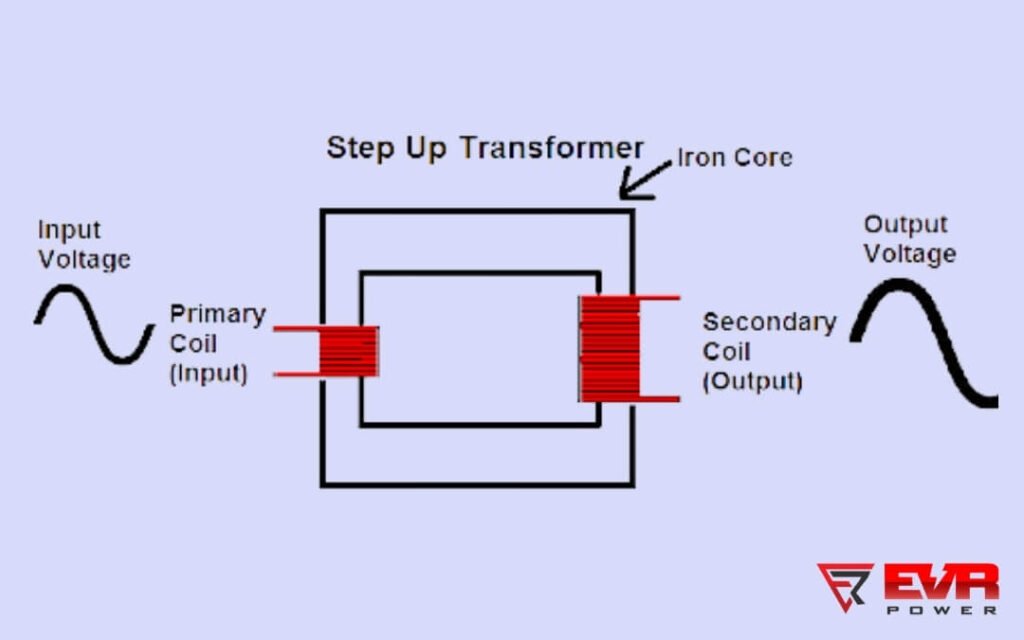In this modern technological era, an uninterrupted power supply is the need of the hour. Every device has a unique purpose and will have its own power needs. The equipment used for industrial purposes will require a much higher voltage than that of the equipment used for domestic purposes.
The Power produced in the generation plants cannot be consumed directly because of two reasons.
Firstly, the power received at the distribution station will be very much lesser than the power generated due to various losses during transmission. Secondly, the distributed power voltage will not be apt for applications across utilities. So we need a device that can match for the losses incurred and also modify the voltage that suits diverse applications. A Step-up transformer serves exactly the same purpose.
In this blog post, we will understand its objective and will weigh the pros and cons of a Step-up transformer.
What is a Step-up Transformer?

A Step-up transformer is an electrical device whose output voltage is higher than that of its input voltage. Let’s say you need to operate electrical equipment that requires 440 V and the main power supply is 220 V, the step-up transformer will increase the 220 V to a certain amount that will fulfill the power requirement of the given equipment.
Step-up transformers are an integral part of the power generation and transmission system. In general, power generating plants are situated far from inhabited places, and the electricity is needed to be transmitted to the point of utility. So a step-up transformer is employed to transform the present power source to a suitable voltage.
At the power station, a step-up transformer steps up the voltage and steps down the current to maintain a constant power level. By reducing the current, Power losses (I2R losses) are minimized. At the distribution stations, the voltage and current are modified corresponding to the generated voltage. As these transformers amplify the voltage to the desired level, they are employed in various applications to fulfill the individual needs of power consumers.
Principle and Construction
A Step-up transformer is typically made up of windings and core along with its enclosures. An assembly of thin Silicon steel tightly clamped and laminated to let the magnetic flux flow with less loss forms the core of the transformer. A well-laminated iron core is most commonly used in transformer construction.
A step-up transformer as like any other transformer consists of two sections – Primary and Secondary.
The primary section contains fewer turns of wire compared to the secondary one. The windings are made of either copper or aluminum that is wound around the core. This is designed in such a way that the primary winding can carry low power voltage compared to the secondary winding which carries high voltage power.
A step-up transformer is used to convert a high-current, low-voltage input to a low-current, high-voltage output applying the principles of electromagnetic induction. The alternating current in the primary winding produces a changing magnetic field in the iron core. This magnetic field then induces the alternating current in the secondary coil. Since the turns of wire on the secondary are more than that on the primary, the received voltage will be boosted up. Thus the output voltage will be higher than that of the input voltage.
Besides Power transmission, Step-up transformers have their applications in electronic systems like inverters and stabilizers to regulate the voltage from low to high.
Step-up transformers play a key role in industries such as steel, textiles, and food processing and also in residential and commercial spaces.

Advantages of a Step-up Transformer
Transformers can come in different specifications suitable for different applications and each comes with its own advantages and disadvantages. Choosing the right step-up transformer for your company is a very critical decision as it impacts the productivity of the industry. So it is very essential to learn the pros and cons of an electrical device before purchasing one. Here are a few advantages of the step-up transformers.
Long-Distance Transmission
Step-up transformers are used to transmit power over long distances at low costs. If it were not for a step-up transformer, the power loss in the transmission lines would be so high and it would become close to impossible to transmit power to far-off regions. How does it do this? Well, when the voltage of the current that has to be transmitted is increased, the resistance on the line is reduced, thus, ensuring very minimal losses along the way.
Uninterrupted Operation
Any electrical/electronic device needs to be switched off for a few hours a day, for it to perform optimally (Yes, your mobile phone needs rest too). Continuous running of electrical equipment can negatively impact its performance. But not in the case of a step-up transformer. They have the capability of operating continuously due to their construction. This is yet another reason why they play a vital role in power distribution systems.
High Efficiency
As we have seen, the step-up transformers minimize losses to a greater extent which makes them more efficient. With the use of cutting-edge technology and great manufacturing processes, transformer manufacturers have made significant improvements to provide optimum efficiency. A standard step-up transformer operates at more than 95% efficiency.
Low Maintenance
Step-up transformers do not require constant maintenance and cut low on maintenance costs. Most of them need only minimal maintenance such as oil checks, repairing any corroded or damaged parts, cleaning the contact, etc., and don’t require much time or money.
No Starting trouble
Once the step-up transformer is installed and connected to the load, it can operate immediately without any delays.
Disadvantages of a Step-up Transformer
Now that you know the advantages and applications of a step-up transformer, it is equally wise to know the disadvantages of a step-up transformer. This aids in planning and making necessary arrangements that helps you to make efficient use of the transformer.
Demands a Cooling System
One of the major disadvantages of a step-up transformer is its need for a cooling system. As it operates 24/7, it heats up a lot and there have to be some means to cool it down. As they are used in highly critical applications, switching them off even for a few minutes can cost a lot to the industry.
On the other hand, too much heating can reduce the lifespan of the transformer. So it becomes necessary to install a cooling system that runs round the clock to suck out the heat produced.
Hefty Device
As the voltage to be stepped up increases, the size of the transformer also increases, as it depends on the number of windings on the core. In other terms, the higher the output voltage, the bulkier is the transformer. Apart from this, the cooling system used also contributes to the overall weight of the step-up transformer. It takes up a lot of space.
Exclusive for AC
As a step-up transformer works only for AC (alternating current) voltages, its applications are limited only to AC operations. It does not do well for direct current or DC voltages.
Conclusion
Choosing the right transformer manufacturer makes a major difference by returning great value for money. EVR Power is one of the established and trusted manufacturers of step-up transformers in Chennai. We have a comprehensive range of superior quality step-up transformers to suit client specifications. Our products are available in different power capacities and are appreciated for noiseless operations. Get your quote now!
Do you have any questions for us? Please feel free to comment below. Have a great day!
FAQS
1.Why do we step up the voltage for transmission?
Normally electricity is generated in power stations and is transmitted to long distances by power lines. The resistance in the power line increases as the distance of transmission increases. So the power companies try to boost the voltage by many KVs before it is transmitted to the power line. (This reduces the current and minimises the power lost in the power lines)
2. How does a step-up transformer increase efficiency?
The efficiency of a transformer is determined by the ratio of output energy to input energy. At the source of power generation (power station), a step-up transformer steps up the voltage and steps down the current. This increases the efficiency in transmitting current in the overhead cables with minimal losses.
3. What is Step-up Transformer?
Step-up transformer: Step-up transformers are used to boost the voltage from the primary winding to the secondary winding keeping the power constant in both windings. The core of the transformer is made up of laminated thin silicon steel and is assembled and tightly clamped. When we step up the voltage, the current is stepped down. This factor makes the current flowing in the overhead cables relatively less and enables them to distribute to long distances. They form an important part of the power generation and distribution system. They are used in electronic devices like inverters, batteries and stabilizers.
4. Use of a step-up transformer?
Uses of a step-up transformer:- A step-up transformer can transmit power over long distances, therefore they are used in power plants. Also, they are used in inverters, microwaves, voltage stabilizers and x-ray machines.


0 Comments
Trackbacks/Pingbacks